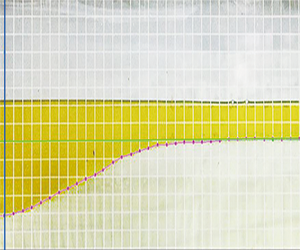Crossref Citations
This article has been cited by the following publications. This list is generated based on data provided by
Crossref.
Yan, Dongyi
Liu, Dongming
and
Lian, Jijian
2022.
Generation of internal waves in a two-layered stratified system with a free surface by coupled mass sources.
Ocean Engineering,
Vol. 243,
Issue. ,
p.
110234.
Kostikov, Vasily K.
Hayatdavoodi, Masoud
and
Ertekin, R. Cengiz
2022.
Drift of elastic floating ice sheets by waves and current: Multiple sheets.
Physics of Fluids,
Vol. 34,
Issue. 5,
Zhi, Chang-Hong
Xu, Shuang-Dong
Han, Pan-Pan
Chen, Ke
and
You, Yun-Xiang
2022.
Applicability of high-order unidirectional internal solitary wave theoretical model.
Acta Physica Sinica,
Vol. 71,
Issue. 17,
p.
174701.
Choi, Wooyoung
2022.
High-order strongly nonlinear long wave approximation and solitary wave solution. Part 2. Internal waves.
Journal of Fluid Mechanics,
Vol. 952,
Issue. ,
Chesnokov, A. A.
Ermishina, V. E.
and
Liapidevskii, V. Yu.
2023.
Strongly non-linear Boussinesq-type model of the dynamics of internal solitary waves propagating in a multilayer stratified fluid.
Physics of Fluids,
Vol. 35,
Issue. 7,
Zhao, Binbin
Zhang, Tianyu
Duan, Wenyang
Wang, Zhan
Hayatdavoodi, Masoud
and
Ertekin, R. Cengiz
2023.
Internal solitary waves in the presence of linear and nonlinear shear-currents.
Wave Motion,
Vol. 123,
Issue. ,
p.
103217.
Zhang, Jiu-ming
Zou, Li
Sun, Tie-zhi
Yu, Zong-bing
and
Wang, Hao
2023.
Discussion on the extended form of internal solitary wave models between two typical stratification systems.
Journal of Hydrodynamics,
Vol. 35,
Issue. 1,
p.
155.
Liu, Jiaqi
Hayatdavoodi, Masoud
and
Ertekin, R. Cengiz
2023.
A Comparative Study on Generation and Propagation of Nonlinear Waves in Shallow Waters.
Journal of Marine Science and Engineering,
Vol. 11,
Issue. 5,
p.
917.
Min, Eun-Hong
Kim, MooHyun
and
Koo, Weoncheol
2023.
Free surface and internal periodical waves generated by an oscillating floater in two-layer fluids using fully nonlinear numerical wave tank.
Ocean Engineering,
Vol. 287,
Issue. ,
p.
115865.
Hayatdavoodi, Masoud
and
Cengiz Ertekin, R.
2023.
Diffraction and Refraction of Nonlinear Waves by the Green–Naghdi Equations.
Journal of Offshore Mechanics and Arctic Engineering,
Vol. 145,
Issue. 2,
Debsarma, Suma
Chakrabortty, Sabyasachi
and
Kirby, James T.
2023.
Highly nonlinear internal solitary waves with a free surface.
Ocean Modelling,
Vol. 185,
Issue. ,
p.
102238.
Chesnokov, A.
Shmakova, N.
Zhao, B.
Zhang, T.
Wang, Z.
and
Duan, W.
2024.
Large-amplitude internal waves and turbulent mixing in three-layer flows under a rigid lid.
Physics of Fluids,
Vol. 36,
Issue. 7,
Zhang, Jiuming
Jin, Guoqing
Cai, Zhiwen
Zheng, Kun
and
Zou, Li
2024.
Numerical investigation on the amplitude and mechanics of internal solitary waves generated by the gravity collapse method.
Applied Ocean Research,
Vol. 150,
Issue. ,
p.
104127.
Chen, Yongbo
Hayatdavoodi, Masoud
Zhao, Binbin
and
Ertekin, R. Cengiz
2024.
Waves Generated by the Horizontal Motions of a Bottom Disturbance.
Journal of Marine Science and Engineering,
Vol. 12,
Issue. 11,
p.
1990.
Kostikov, Vasily K.
Hayatdavoodi, Masoud
and
Ertekin, R. Cengiz
2024.
Moored elastic sheets under the action of nonlinear waves and current.
Marine Structures,
Vol. 93,
Issue. ,
p.
103542.
Zhang, Tianyu
Wang, Zhan
Zhao, Binbin
Hayatdavoodi, Masoud
Ertekin, R. Cengiz
and
Duan, Wenyang
2024.
On the application of Miyata-Choi-Camassa model to surface waves.
Ocean Dynamics,
Vol. 74,
Issue. 9,
p.
725.
Fan, Wenhao
Zhi, Changhong
and
You, Yunxiang
2024.
A modified experimental approach for generating internal solitary waves using the dual paddle technique.
Physics of Fluids,
Vol. 36,
Issue. 9,
Zhao, Binbin
Zhang, Tianyu
Wang, Zhan
Hayatdavoodi, Masoud
Gou, Ying
Ertekin, R. Cengiz
and
Duan, Wenyang
2024.
High-level Green–Naghdi model for large-amplitude internal waves in deep water.
Journal of Fluid Mechanics,
Vol. 988,
Issue. ,
Zhao, Bin-bin
Zhang, Tian-yu
Wang, Zhan
Duan, Wen-yang
Chesnokov, Alexander
and
Shmakova, Natalia
2024.
On the two-layer high-level Green-Naghdi model in a general form.
Journal of Hydrodynamics,
Vol. 36,
Issue. 1,
p.
78.

 $\rho _{2}/\rho _{1}=0.977$ and
$\rho _{2}/\rho _{1}=0.977$ and  $h_{2}/h_{1}=1/4.13$, where
$h_{2}/h_{1}=1/4.13$, where  $\rho _{2}$ and
$\rho _{2}$ and  $\rho _{1}$ are the densities of the upper-fluid layer and the lower-fluid layer, respectively, and
$\rho _{1}$ are the densities of the upper-fluid layer and the lower-fluid layer, respectively, and  $h_{2}$ and
$h_{2}$ and  $h_{1}$ are the depths of the upper-fluid layer and the lower-fluid layer, respectively. The second case is also a shallow configuration, where
$h_{1}$ are the depths of the upper-fluid layer and the lower-fluid layer, respectively. The second case is also a shallow configuration, where  $h_{2}/h_{1}=1/5$ while
$h_{2}/h_{1}=1/5$ while  $\rho _{2}/\rho _{1}=0.859$. The third case is related to the present physical experiments, where
$\rho _{2}/\rho _{1}=0.859$. The third case is related to the present physical experiments, where  $\rho _{2}/\rho _{1}=0.869$ and
$\rho _{2}/\rho _{1}=0.869$ and  $h_{2}/h_{1}=1/15$. It is shown that the MCC-FS model can provide accurate results for the shallow configurations. Meanwhile, the HLGN-FS model is shown to be accurate for describing the internal solitary waves for both shallow and deep configurations.
$h_{2}/h_{1}=1/15$. It is shown that the MCC-FS model can provide accurate results for the shallow configurations. Meanwhile, the HLGN-FS model is shown to be accurate for describing the internal solitary waves for both shallow and deep configurations.

